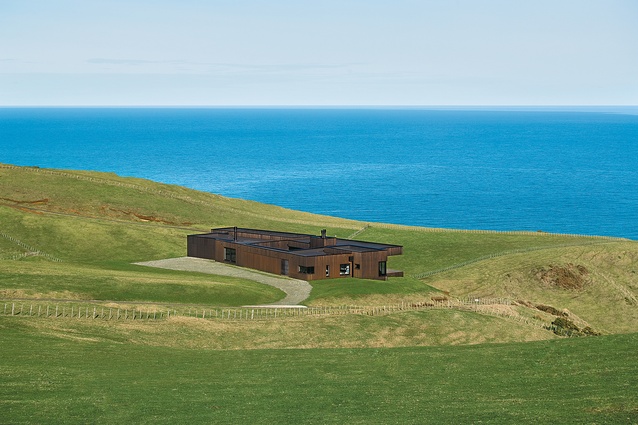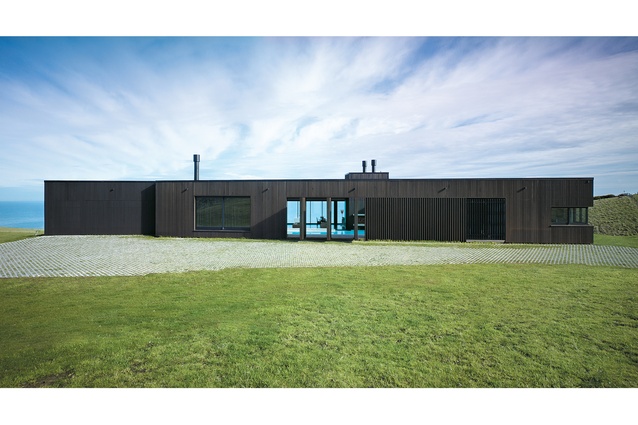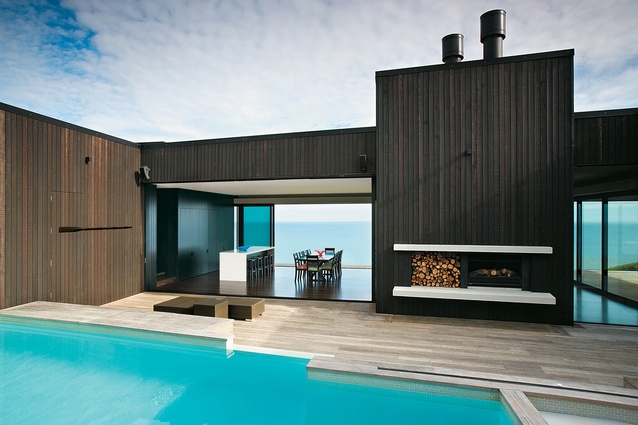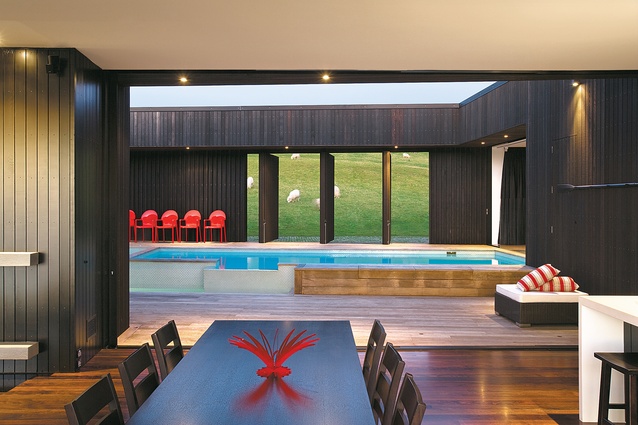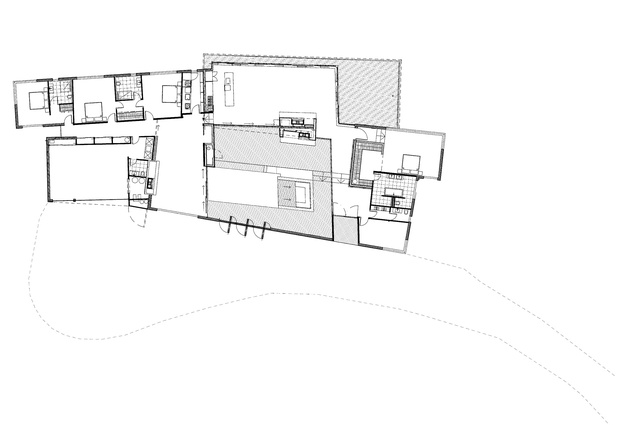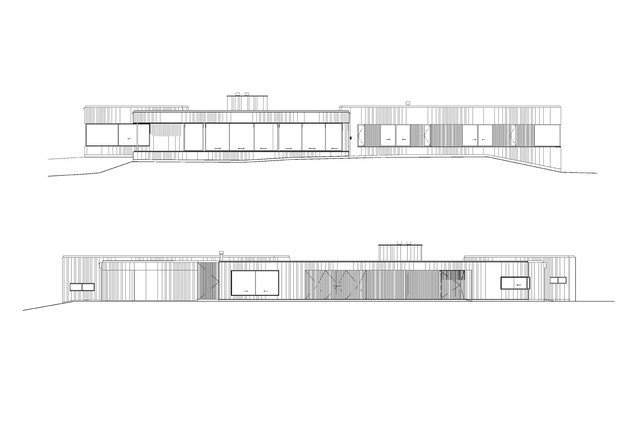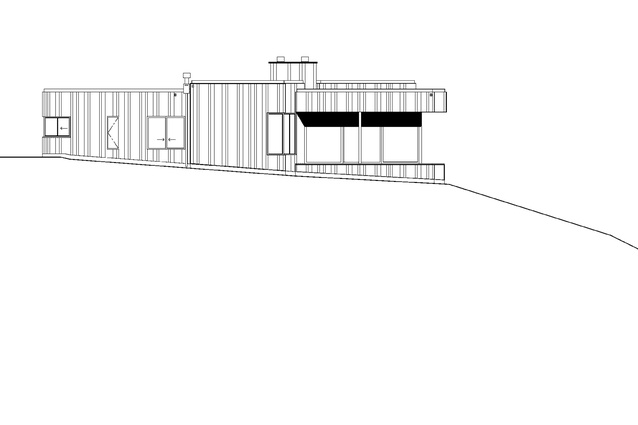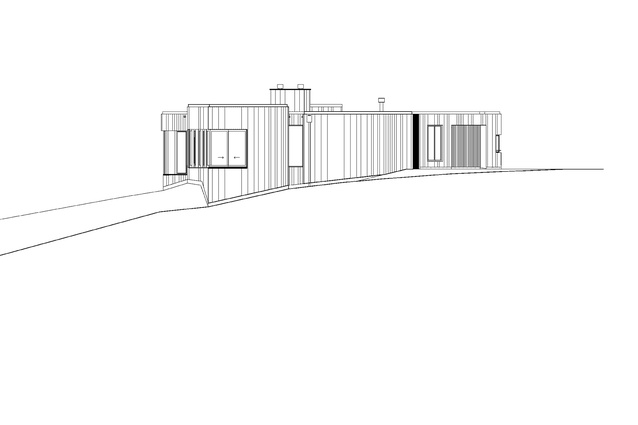Houses Revisited: Keep in shape
Take a look back at an Andrew Patterson-designed contemporary castle with a twist on the cliffs above Auckland’s west coast.
What could be a more un-New Zealand architectural type than a castle? We don’t have castles here. Our architectural canon, fortress or otherwise, is based on timber – sticks, not stones. Yet, while the castle is a foreign form here, it is of course pervasive in literature and the wider culture. Not to be too Jungian about it, it’s in the collective consciousness, and for architects, too, it’s a rich lode to be mined.
Architect Andrew Patterson wasn’t blindly fumbling for a model with resonance when he hit upon ‘castle’. Rather, as with all of his designs, the shape of this house was informed by its site. Visiting this gusty headland resting above dramatic cliffs at Muriwai, on the West Coast of Auckland, Patterson saw the resemblance to those battered ridges in Europe where castles had been sited in the Middle Ages.
“It is a lonely, not desolate, but powerfully romantic seascape, similar to the Irish coast,” Patterson says. “Some of the most beautiful marriages of buildings and landscape are those castles in Ireland, forts on the Mediterranean, Moorish citadels on the edge of Atlas Mountains, and so we looked at those examples. A thousand years ago, this site would have had a tower or a lookout. It was continuing that idea.”

The site is everything here. On the edge of a 200-hectare farm spread over the peninsula, the house shrugs into a depression and looks out to the west between two hills. It’s as Kiwi as you get: a working sheep farm, with the ocean churning below, and windswept native bush clinging to the land.
Fast-forward from Europe in the Middle Ages to the Antipodes in the twenty-first century and your castle becomes a different proposition altogether. This is “a fort protecting from the elements rather than protecting from the hordes,” Patterson says. Like those decaying castles on the cliffs of Ireland, this fortification seems to hug the ground. It seems to have been pushed up through the crust rather than built, block by block, on top of the land.
The first glimpse of the house comes as you drive over the ridge and see it below: the roof is what Patterson calls “the fifth elevation”. Interlacing blocks with heavy parapets create shaded frames like ramparts. From the ridge, looking down, the house in its darkness resembles the black iron sand on the beaches far below; then your eye adjusts, the bulk comes into focus and you see it as a building.
The gravel approach is winding, and as you descend the hill the house’s front elevation becomes partly hidden by a crest of a hill until you swing the car in around and the dark wall is revealed at the last moment. Along the front elevation – the eastern façade to the landward side – the dark timber wall twists slightly, mimicking the switchback tracks up the farm in the background. At the end the wall dovetails to create a little flick around where the garage is, protected from the prevailing wind. Punctuating the wall is the change in the timber’s application over big pivoting doors that swing out connecting the exterior to the courtyard.
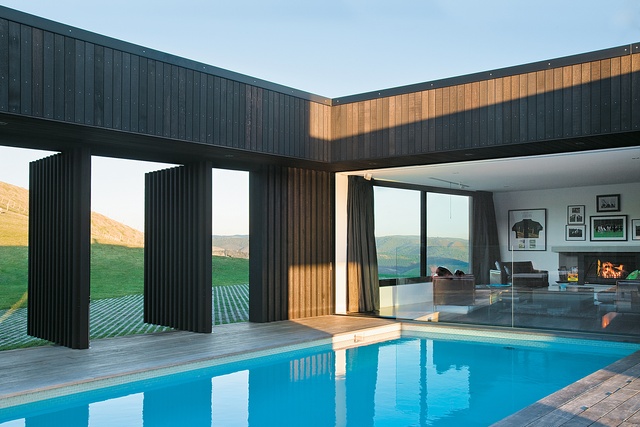
The black cedar façade will inevitably evoke comparison to the architecture of Stevens Lawson, yet the house was designed in 2003, when Nick Stevens and Gary Lawson were only starting to play with that blackened aesthetic. The originality and distinctive design of the Patterson-designed house didn’t win it any favours from the Auckland Regional Council; the house was completed only after a lengthy and highly publicised battle for consent.
Initially the design seems to follow a straightforward rectilinear plan. There are no dramatic slanting of geometries; rather, subtle skews from ninety degrees create the casual passage through the house, opening areas to view shafts and creating alcoves. This skewing is no accident, of course. “When you look at those romantic Irish castles, they’ve often been built and added onto, nothing is square, it is all off keel,” Patterson says. “There is a sense of history and romance beyond its age. It links an earlier time and a later time and gives the house a kind of personality.”
The three degree shift from square recalls another Patterson system: ‘the Shape’, a twisted trapezoid that has been developed in projects such as the Hills Clubhouse. In this house, though, the use of the Shape is a little more relaxed, Patterson says. “That off-shape cube is translated into a 3D volume – it’s almost done it in a deconstructivist way by taking two angles and moving it round the house.”

The entry cascades down from the landing through an imperceptibly fanned hall that prepares you for the opening up as you arrive in the lounge, with its huge, gaping sea view fanning out in front. From the main living, you are then drawn to the family room and through the corridor to the children’s bedrooms and guest bedroom which terminates in a cantilevered corner of glass that continues the gaze through the room and over the farm. The house leads you through itself like a child softly tugging on your hand; the architecture plays the role of a guide.
The black timber aesthetic is carried from the cladding to the interiors with vertical strips of waxed stained timber creating an anchor in each room. The strips are nailed with medieval-looking four-headed nails. As are castles, this house is filled with secret passages and doors. Along the entry hall, for example, an invisible door, seamlessly integrated into the timber panelling, leads through to the master bedroom.
Though the house, especially viewed from the approach, has a sense of grandeur and immensity, it feels as if the architect has tried to soften the scale on the inside, to give the house less of that castle-like scale and more of a domestic one. It is certainly protected, as it has to be on this site – this ‘castle’ boasts a sheltered courtyard with pool – but inside this is actually a very simple and straightforward house, used by a family as a true home. There is no pretence or preciousness here; the house, even with its intricate detailing and feudal precedents, is very much of its place.
This article first appeared in Houses magazine


